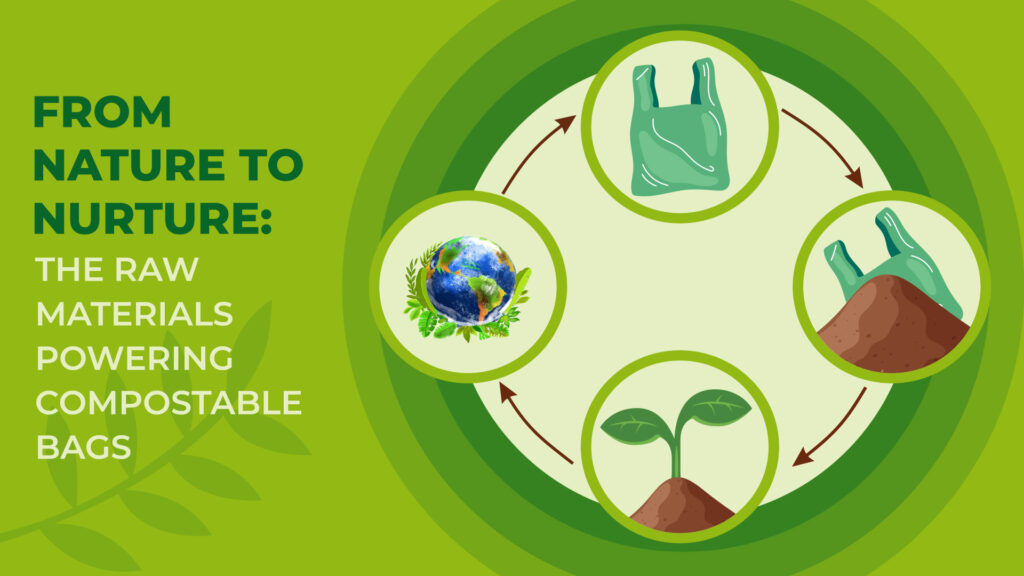From Nature to Nurture: The Raw Materials Powering Compostable Bags

Introduction: The Need for Change
As the world faces growing environmental challenges, the urgency for sustainable alternatives to single-use plastics has never been greater. Over 300 million tons of plastic are produced annually, with approximately 8 million tons ending up in the oceans. Compostable bags have emerged as an eco-friendly substitute, offering reduced pollution, faster decomposition, and a more sustainable future. However, the raw materials used in their production play a crucial role in their effectiveness. In this segment, we’ll explore what makes biodegradable bags truly sustainable and the materials that are driving this movement.
What Makes a Bag Compostable?
A compostable bag is designed to break down naturally with the help of microorganisms, decomposing into harmless natural elements within a short time. In contrast, traditional plastic bags can take hundreds of years to degrade, posing long-term environmental hazards.
Biodegradability vs. Compostability
While both terms relate to decomposition, they have distinct meanings. Compostable materials not only break down but also enrich the soil with nutrients. For a bag to be compostable, it must be made from raw materials that comply with specific disintegration, toxicity, and environmental safety standards.
Importance of Raw Materials
The choice of raw materials determines the environmental impact of biodegradable bags. Since these materials originate from nature, they should return to nature without causing pollution. Selecting the right biodegradable and compostable raw materials is the first step toward creating truly sustainable packaging solutions.
3. Key Raw Materials Used in Biodegradable Bags
PLA (Polylactic Acid)
PLA is a bioplastic derived from fermented starchy materials like corn or sugarcane. It has gained popularity due to its strength, biodegradability, and transparency. In 2021, global PLA production reached 290,000 tons, reflecting its growing demand in eco-friendly packaging. PLA decomposes under industrial composting conditions, making it a viable option for controlled environments.
PHA (Polyhydroxyalkanoates)
PHA is a class of biopolymers produced by microorganisms. Unlike some biodegradable plastics, PHA breaks down in marine, soil, and industrial composting conditions. Made through organic feedstock fermentation, PHA is a sustainable alternative for plastic bag production, decomposing completely in marine environments within approximately six months.
PBAT (Polybutylene Adipate Terephthalate)
PBAT is a biodegradable polymer that enhances flexibility and strength when combined with other materials like PLA. Unlike conventional plastic packaging, which lingers in the environment, PBAT decomposes efficiently without leaving harmful residues.
Starch-Based Materials
Starch-based materials, derived from renewable sources like potatoes, corn, and cassava, decompose quickly and are ideal for environmentally friendly packaging. These materials are often blended with bioplastics to enhance durability while maintaining biodegradability.
Cellulose
Cellulose, sourced from wood or agricultural waste, is a natural polymer that decomposes without leaving toxic residues. Due to its biodegradability and availability, cellulose is widely used in producing eco-friendly bags.
Sustainability Criteria for Biodegradable Bags
To ensure true sustainability, the raw materials used in biodegradable bags must meet the following criteria:
- Renewable Sources: Materials should be derived from plants or microorganisms.
- Non-Toxicity: Decomposed materials should not release harmful chemicals into the soil or water.
- Energy-Efficient Production: The production process should minimize energy consumption and carbon emissions.
The Lifecycle of a Biodegradable Bag
Manufacturing Stage
Raw materials are processed into biopolymers through fermentation or polymerization. The focus is on minimizing energy use and waste. For example, manufacturing 1 kg of PLA emits 75% fewer greenhouse gases compared to traditional plastics.
Usage Stage
Biodegradable bags serve multiple functions, from carrying groceries to packaging. Their durability and functionality make them viable replacements for conventional plastic bags without compromising usability.
Decomposition Stage
Upon disposal, biodegradable bags break down in composting sites or natural environments. Depending on the material, decomposition can take weeks to months, leaving no toxic residues. Under optimal conditions, compostable bags decompose within 60–90 days.
PBAT: A Game-Changer in Biodegradable Packaging
PBAT stands out for its flexibility, strength, and high biodegradability. While PLA requires industrial composting, PBAT decomposes in home composts and soil. When blended with starch-based materials, PBAT enhances the production of various biodegradable bag variants, making it a cornerstone of eco-friendly packaging solutions.
Environmental Benefits of Biodegradable Raw Materials
Reducing Landfill Waste
Biodegradable materials decrease landfill accumulation and prevent plastic waste from polluting oceans. Studies suggest that increasing the use of biodegradable alternatives could cut plastic waste volume in water bodies by 50% over the next decade.
Lower Pollution Levels
Raw materials like PLA and PHA come from renewable sources, helping offset greenhouse gas emissions. Bioplastics have been shown to reduce carbon footprints by more than 70% compared to petroleum-based plastics.
Soil and Water Conservation
Unlike conventional plastics that release harmful microplastics, biodegradable bags break down into non-toxic components that enrich the soil and dissolve harmlessly in water.
Efficient Resource Utilization
Using agricultural byproducts like starch and cellulose ensures resource efficiency without competing with food supply chains.
Why Choose Neusmart Green Lyf Biodegradable Bags?
Neusmart Green Lyf compostable bags combine sustainability, durability, and practicality. Our commitment to high-quality compostable raw materials, such as PLA, PBAT, and starch, ensures:
- Low Carbon Footprint: Our production processes prioritize energy efficiency and minimal emissions.
- Natural Decomposition: Our bags break down safely, contributing to environmental conservation.
- Reliable Performance: Designed for everyday use without compromising functionality.
Conclusion: A Call to Action
Neusmart Green Lyf biodegradable bags represent a shift toward sustainability. Transitioning from plastic to eco-friendly alternatives is no longer optional—it’s essential. Together, we can create a greener future by making responsible choices that benefit both the environment and future generations.